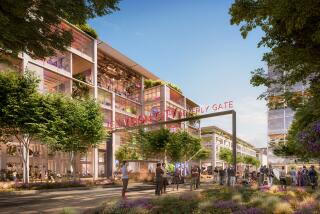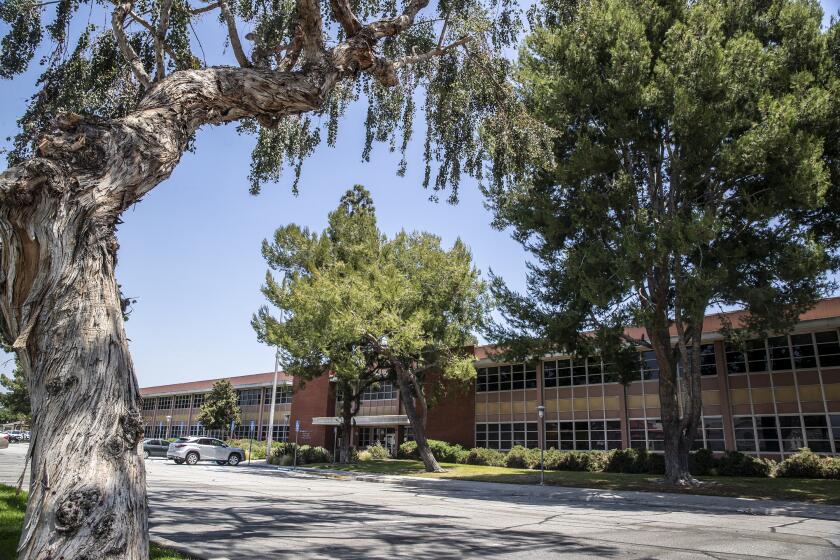Plans for L.A.’s old U.S. Courthouse hit a roadblock in Congress
- Share via
The imposing white U.S. Courthouse on Spring Street overlooking the 101 Freeway has hosted some of Los Angeles’ most memorable legal dramas.
Clark Gable and Charlie Chaplin faced paternity trials there. The House Committee on Un-American Activities convened at the court for hearings on communism in Hollywood. In the summer of 1971, Daniel Ellsberg spoke out against the Vietnam War on its front steps as he defended himself in the Pentagon Papers case.
But the grand courthouse now sits at the center of a political battle over its future.
The Obama administration has approved plans to vacate the 72-year-old tower and build a new $400-million courthouse and federal office building on an empty lot at 1st Street and Broadway, with work slated to begin later this year. The plan has an unusual twist: Federal officials say they will pay for a portion of the project by selling the old courthouse to a private developer.
Republicans in the House of Representatives, however, doubt the U.S. General Services Administration can find a buyer for the aging courthouse, putting taxpayers on the hook for the full costs of the new complex and leaving Los Angeles with far more federal courtrooms than it needs.
“It’s unclear how these numbers actually add up,” said Rep. Jeff Denham (R-Atwater), a freshman congressman from the Central Valley, adding that the plan was “definitely a sham.”
Denham and other Republicans on the House Committee on Transportation and Infrastructure have spent months criticizing the GSA for a variety of actions ranging from spending on a conference in Las Vegas to employee bonuses and unnecessary construction projects. The L.A. courthouse has increasingly become a part of this larger campaign.
Downtown L.A. has numerous historic buildings that have been transformed into lofts and office space, including the old Federal Reserve building on Olympic Boulevard that was converted a few years ago into luxury apartments.
But even downtown real estate brokers and land use experts are skeptical that the aging Spring Street courthouse would make sense for a developer.
“It’s obviously a creative idea, it’s well-intentioned, but it’s riddled with challenges,” said Paul Habibi, a professor at the UCLA Ziman Center for Real Estate. “It’s going to be a difficult deal to pull off.”
Arty Maharajh, an analyst at Transwestern Commercial Real Estate, was more blunt: “For a developer, it just looks like more trouble than it’s really worth.”
Under the GSA proposal, a “private partner” would take over the old courthouse. The federal government would pay for construction of the new courthouse. But the private partner would cover the costs of building the adjacent federal offices as well as rehab the old courthouse for private tenants.
The problems, experts said, start with the relatively soft market for office space downtown, which currently has a 16.7% vacancy rate, Maharajh said. And the strongest demand comes from technology and media companies that typically gravitate toward spaces with lots of amenities.
Although some pockets of downtown have thrived in recent years — such as the Arts District and South Park — the Spring Street courthouse sits in a much sleepier area. Maharajh called the site a “no-man’s land” flanked by the freeway and a series of government buildings. One would have to walk several blocks to get to the galleries and restaurants of the Old Bank District or the museums of Bunker Hill.
Then there’s the cost to rehabilitate the old courthouse: The GSA has estimated that, for its purposes, it would take about $250 million to renovate the 700,000-square-foot, 19-story building. Asbestos is a problem, seismic upgrades are necessary, and the elevators and electrical systems need major fixes.
Based on that number — and the cost to construct the new, 150,000-square-foot federal office building at 1st Street — Habibi figured a private developer looking to lease the old courthouse as office space would need to charge roughly $4.80 a square foot each month.
“That’s a ballpark,” he said. “And that ain’t gonna happen downtown.”
The average monthly rate for office space downtown is $2.87 a square foot.
There is also the issue of the courthouse’s historic status, which would require a private party to participate in a public hearing process on any major changes envisioned for the building.
Such bureaucratic hoops — and the prospect of partnering with the federal government — could further sour developers on a courthouse deal.
“I do think it’s the right idea to figure out how to do these public-private partnerships, because the government is going to struggle to get anything going on its own,” said Gail Goldberg, a former city planning director who now runs the Urban Land Institute of Los Angeles. “But developers need to go through things quickly, and they need certainty.”
At a subcommittee hearing last month on the project in Los Angeles, two GOP congressmen took turns denouncing the GSA’s exchange proposal. They were concerned in part because the GSA doesn’t know yet how much the government can get for the old courthouse.
“Correct me if I’m wrong.... Show me how this pencils out even in the broadest terms, in the best market,” Denham said, as he read from a story about the project in the Downtown News. “I mean, who’s running the shop over there?”
Denham said he sees a parallel to the L.A. courthouse battle with the situation in Miami. There, the GSA built a new courthouse, but an old courthouse sits vacant across the street, he said, and Miami now has more courtrooms than it needs.
Kevin Richards, acting commissioner for the GSA’s Pacific Rim Division, said he couldn’t answer specific questions about the Los Angeles exchange proposal until the agency completed the historic preservation procedure to determine what types of uses would be possible there. He also said the GSA hadn’t yet met with any private developers to discuss interest in the Spring Street courthouse.
Despite the criticism, the GSA said it still plans to move forward on construction of the new courthouse, even before a partnership with a developer is finalized. The agency, which has been trying to build the courthouse for more than a decade, cites support from 19 Democrats in Congress, along with local officials, business and labor groups. While Republicans are trying a last-ditch effort to
derail the project, courthouse backers are confident work will began as scheduled.
The current proposal is not as elaborate as once envisioned, with 24 courtrooms instead of the 54-courtroom, $1.1-billion design floated several years ago. GSA officials said they expect to award a construction contract later this year, with a targeted completion date of 2016.
Los Angeles politicians and federal justices say they are thrilled at the possibility of a new facility. The judges have for years complained of security issues at the Spring Street courthouse. Downtown boosters see the project as a chance to fill a conspicuous dirt lot in the middle of the Civic Center.
More to Read
Sign up for Essential California
The most important California stories and recommendations in your inbox every morning.
You may occasionally receive promotional content from the Los Angeles Times.










